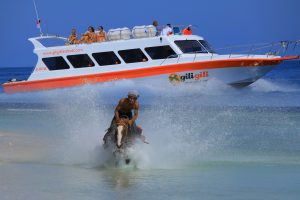
BOOKING YOUR TICKET NOW!
SPECIAL OFFER 45% OFF
PROMO
CODE
NEWBOAT
BOOK PERIOD UNTIL APRIL 30TH, 2025
TRIP PERIOD 1-31 MAY, 2025
 Gili Trawangan, the most popular among the three Gili’s. Just kick back and enjoy the sun, nightly beach parties and sea. The main stripe is full of accommodations, restaurants, and dive shops. If you are seeking a quieter place to stay there are bungalows in the north. This Island is also known as“Party Island”, where mostly young European find themselves “Lost In Paradise”.
Gili Trawangan, the most popular among the three Gili’s. Just kick back and enjoy the sun, nightly beach parties and sea. The main stripe is full of accommodations, restaurants, and dive shops. If you are seeking a quieter place to stay there are bungalows in the north. This Island is also known as“Party Island”, where mostly young European find themselves “Lost In Paradise”.
If you come during the Peak Season (July-August, December-January), most places are full and prices are doubled. An advanced reservation is a must.
With spectacular sunrises over Lombok’s Mount Rinjani volcano and breathtaking sunsets that illuminate Bali’s towering Mount Agung volcano, together with the warm hospitality of the Gili Trawangan residents, it’s not surprising that most visitors end up staying longer than the original plan.

Most of the accommodation centrally located on the south-east of Gili Trawangan. A few new establishments of bungalows with better facilities are now available. Places in the front (beach line) are more expensive. The upmarket accommodation is no longer dominated by Villa Ombak and Villa Almarik. There are many new quality boutique resorts are now available (see places to stay, updated recently). Gili Trawangan is more developed than other Gilis for the last few years. There are also a few places to stay around the north and south-west coast in the more quiet atmosphere.
Snorkelling off-the-shore, sunbathing, swimming, or join any dive trips with any dive operators which coloured the lines. There are quality dive schools available to cater to the needs of tourists, offering a complete range of PADI courses, as well as Fun Dives for those already certified.
By night, the waterfront comes to life as various foreign and local restaurants and bars start to fire up, with fresh snapper, grouper and tuna, cooked over charcoal flames, readily available.
A local initiative was set up to help the turtle population around Gili Trawangan. The poachers are paid for their find and the turtles are re-buried and kept under surveillance. Once they hatch, the baby green and hawksbill turtles are placed in a tank and left to grow until they are approx. 6 months old when they are big enough to fend for themselves and are released into the sea.
The project still relies purely on donations by locals and tourists and has grown bigger and bigger over the years.
In 2004, Vila Ombak Diving Academy began a project to encourage the re-growth of the coral using a method called Bio-rock. The process involves using a safe low-voltage current that is applied through the sea water. The electric current attracts the minerals in the seawater to a steel structure where they grow into limestone very similar to coral reefs.
In 2006, after the success of the original project, all the dive operators on the island came together to construct more Biorock structures. The 14 structures can be found in the shallower waters (5-8m) at different points just in front of each dive shop.
Gili Eco Trust was set up to protect the coral reefs around the island against destructive fishing practices.
A one-time donation of Rp 40,000 charged to the guest by dive centres on Gili Trawangan to pay fisherman to stop using fishing methods that are damaging to the reefs. Funds are also used for beach cleaning, rubbish management and monitoring.
Line fishing, spear fishing and surface nets are permitted as these methods are not harmful to the reefs and the eco-system.
Although the island once had a reputation among the backpacking community as a wicked party destination, many establishments which once laid claim to hosting wild dance parties today trade on their reputations.
By a tradition that continues today, only one establishment per night can play music and host dance party until 4 am. Of the seven weekly venues hosting parties, the one most anticipated by tourists and locals alike are the funk house and hard music parties with local DJ’s in spinning disks.
If wild dance parties are not to your liking, many restaurants and bars, including the Tir Na Nog – Irish bar, provide a range of more sedate and social gathering point for Alfresco dining and drinking by the water’s edge.